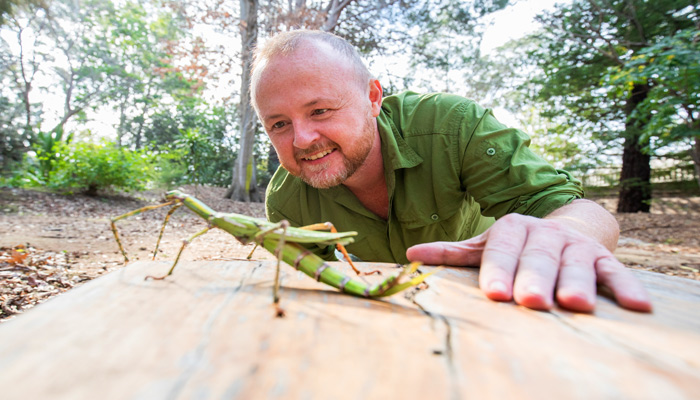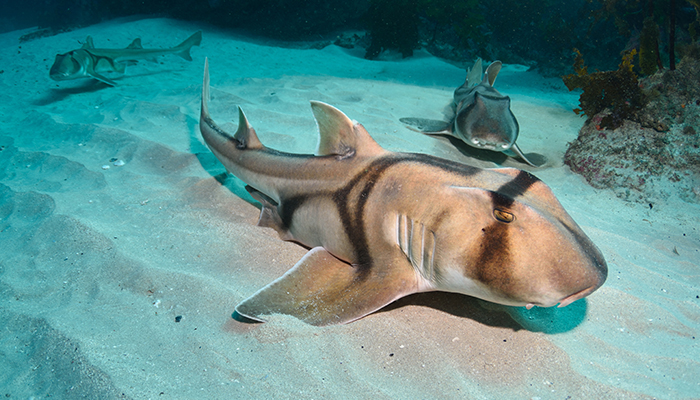Climate change isn’t just warmer days – it’s an adaptation challenge. The hotter ‘new normal’ may prove too much for species that lack resilience.
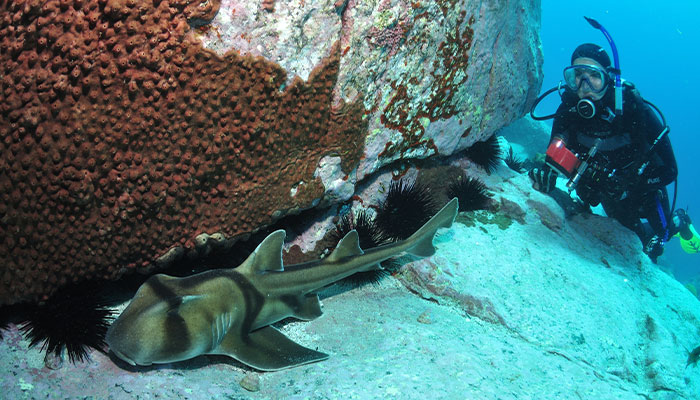
Hot and cold: A Port Jackson shark in the waters off NSW, where the warmer water means they may be more resilient to climate change than Port Jacksons in more southerly climes.
Macquarie researchers have been looking at the climate resilience capacities of sharks and grasshoppers, to see what a heating planet may mean for them. There is good news, bad news, a new challenge for research, and the possibility of smarter, faster-swimming sharks, in smaller numbers.
But most importantly, these studies represent a new way of looking at species’ resilience, in terms of their local responses to a global crisis.
Dr Connor Gervais from Macquarie University’s Fish Lab, together with colleagues from James Cook University and Flinders University, has been studying how sharks respond to a 3° C increase in water temperature. They collected Port Jackson shark eggs from the northern and southern edges of their range – Jervis Bay in NSW and Adelaide respectively – and reared them in controlled lab conditions.
The good news is that some individuals are more resilient than others and may be better placed to cope with climate change.
They found the juvenile sharks had notably different responses to warmer water, depending on where they came from. Both the conditions they were reared in and the location they were originally collected from shaped their climate change coping ability.
The team looked at the sharks’ critical thermal limit (how hot the water gets before sharks lose equilibrium), swimming activity and resting metabolic rate, as key indicators of their ability to respond to rising temperatures. Adelaide sharks, used to cooler water, were less able to cope with increases in water heat than their warm-ish water NSW cousins.
“The good news is that some individuals are more resilient than others and may be better placed to cope with climate change. This may mean that some populations will persist as water temperatures rise," says Gervais, the study lead author.
"The bad news is that many of our climate models examining species distributions in the future are likely wrong. They don’t account for inherent variability."
Genes versus environment
After observing how each population coped when reared under either present-day temperatures or the 3° C higher temperature predicted by the end of this century, the team looked at whether the different responses were caused by inherited capabilities or by the temperature they were reared in. They did a reciprocal-cross experiment, rearing both populations in similar temperatures. The results indicate that both are part of the story.
Rearing temperature, population of origin, and the interaction between the two had a noticeable impact on the resting metabolic rate of juvenile sharks. But once the sharks were active, rearing temperature became a factor.
Sharks from the cooler Adelaide population were much more sensitive to warmer temperatures, doubling their metabolic rate under warmer temperatures, while sharks from Jervis Bay showed little change.
The sharks also became more active in warmer waters. This may be as a result of – paradoxically – attempts to conserve energy, because of hunger, or because in warmer waters, swimming faster is more energy efficient. But as conditions worsen, swimming activity eventually declines.
This research provides a clear indication that different populations of the same species will not necessarily feel the effects of climate change in the same way.
Researchers do not yet fully understand the mechanisms behind thermal tolerance, but there is some evidence that with acute warming, sharks swim less, possibly because they can no longer get enough oxygen to fuel their bodies.
This research provides a clear indication that different populations of the same species will not necessarily feel the effects of climate change in the same way. “The results highlight the need to pay more attention to the variability in responses to rising water temperatures," Gervais says. "Clearly some populations are going to be more heavily impacted than others.”
- Why we need more brazen hussies in Australia today
- To Russian women, with love: trilogy celebrates forgotten filmmakers
Head of the Fish Lab Professor Culum Brown agrees: “It seems we need to be careful about how we model species responses to future climate change scenarios," he says. "Our results show that individuals from different parts of the species distribution may be more or less resilient than previously thought. Our models need to account for that variability.”
Previous research from the Fish Lab also showed that the survival of juvenile sharks at +3° C was substantially lower than when raised in present-day conditions, but those that lived tended to be smarter.
Apex predators are not the only creatures for which selection pressures by location are important. Far down the food chain, alpine grasshoppers are also feeling the heat.
Same locale, different adaptations
Knowing about the geographic scale at which adaptation occurs is critical for predicting species’ distributions and the impacts of environmental change. There has been a great deal of attention on adaptation at broad scales – hundreds or thousands of kilometres – and relatively little work done at the metres to tens of kilometres scale.
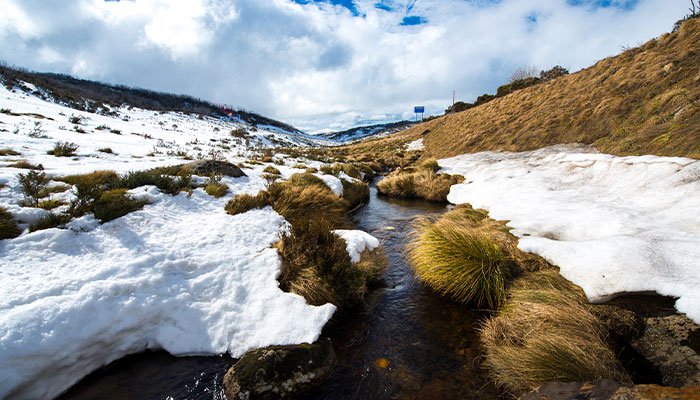
Highland home: Snow melt in the climate change-sensitive Australian alps, home to two species of grasshoppers studied for their adaptive capabilities.
Yet this is the range at which adaptation can occur in smaller, geographically restricted, often environmentally crucial, species.
Sonu Yadav and her colleagues from Macquarie’s School of Biological Sciences have been studying two species of Australian alpine grasshoppers. Both species are restricted to Australia’s alpine and subalpine region. Alpine regions, with climatic gradients in distances measured in tens of metres, are ideal locations for studying selection processes across small ranges.
They found contrasting patterns of adaptation in two related species that occur in the same area. One species (Kosciuscola tristis) has a narrower elevational range and lower thermal tolerance. An analysis of its genome shows stronger genetic differentiation and more evidence for adaptation to fit its localised environment, compared with Kosciuscola usitatus, which has a broader elevational distribution and higher thermal tolerance.
With the predicted increase in temperature in the alps it is important that we characterise the evolutionary resilience of alpine specialist species.
Another study by the same group showed the relative numbers of both grasshoppers changed with elevation, K. usitatus decreasing and K. tristis increasing in higher elevation habitats. Both species also changed body size, decreasing with elevation in both male and female K. usitatus, and in female (but not male) K. tristis. K. tristis is also known for its reversible colour change behaviour: individuals change colour from black to turquoise
Both these species are flightless, mate only once in their lives, and have a short growing and mating season. With moving out of the question, the only option is adapting.
- Against the odds, festive season shopping is set to break records
- Job cuts in middle management risk losing key innovators
But adaptation may not be enough. With more limited gene flow and greater adaptive divergence, K. tristis is likely to be more sensitive to future shifts in climatic and landscape conditions compared to K. usitatus.
“Alpine regions are most sensitive to climate change, and Australian alps are no exception," says Sonu Yadav, lead author of both studies.
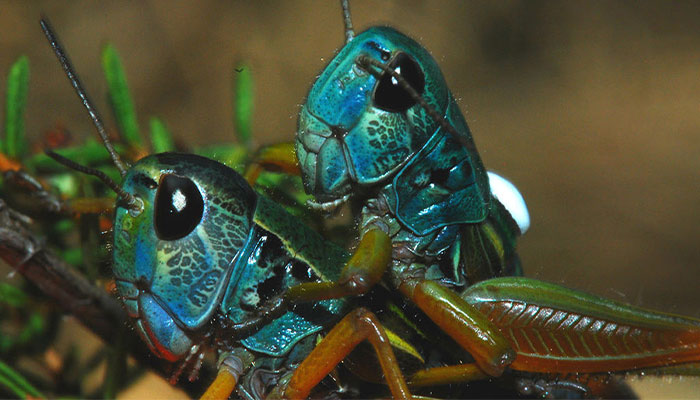
Chameleons: Male K. tristis grasshoppers, which change colour from black to turquoise, and are likely to be sensitive to future shifts in climate. Photo credit: Courtesy of Dr Kate Umbers
"The region has shallow elevation gradients providing little opportunity for alpine restricted species to migrate towards cooler, higher elevations. This poses a big threat to alpine specialist species with limited dispersal capacity and one generation per year.
"With the predicted increase in temperature in the alps it is important that we characterise the evolutionary resilience of alpine specialist species.”
These findings demonstrate that elevation and climatic variables are major drivers of local adaptation, even at very small spatial scales. Even subtle climate changes could be challenges for insects restricted to alpine areas. Some may not survive.
Given its increased local adaptation and reduced genetic connectivity, K. tristis, with a narrower niche, may have equally little evolutionary room to move under rapidly changing climatic conditions.

